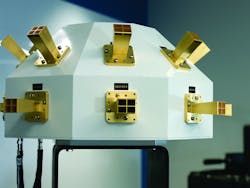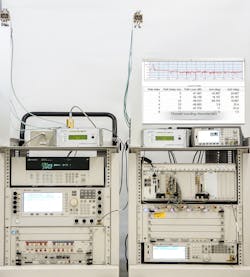Last January, National Instruments released a transceiver system for modeling the behavior of millimeter waves, a far-out class of high frequency bands that wireless companies have pegged for 5G communications. It came with channel coding software and could be custom programmed for testing wireless propagation.
Nokia was the first to employ the system for sounding out wireless infrastructure equipment that used 60 gigahertz signals. This week, National Instruments revealed that AT&T is also using the system in its custom tool for modeling how millimeter waves interact with trees, buildings, cars, and crowds of people.
AT&T’s willingness to show the tool publicly hints at the importance of channel models in the 5G development process. The tool, called the Porcupine for its crown of horn antennas, will help the wireless carrier with tricky tests like vehicle connectivity and plan how it should space out 5G equipment in the next few years for the best coverage.
The tool, used internally by AT&T, can monitor millimeter wave channels in real-time. It provides angle-of-arrival measurements that take around 15 minutes with traditional tools in under 150 milliseconds, the company said. Since data is collected almost instantly, engineers can check the tool’s accuracy in a short time.
That responsiveness helps cut down on time spent recalibrating tools for repeat experiments or additional tests in one location. That is significant because millimeter waves are uncharted territory for most wireless carriers, who are spreading out from lower frequencies in search of greater capacity and faster downloads.
“Utilizing mmWave spectrum for mobile 5G presents many challenges which we believe can be solved,” Marachel Knight, AT&T's vice president of wireless network architecture, said in a statement. “We identified early on that designing and real-time monitoring of mmWave spectrum needs to be much more precise than today’s cellular systems."
That has much to do with the tricky side effects of millimeter waves. Walls and other objects block out signals, which can also be absorbed by oxygen over long distances. These obstacles can be avoided by beaming signals into devices over short distances. But companies are still learning how millimeter waves act in large, complex networks.
The migration to higher bands is not slowing down. Last year, officials at the Federal Communications Commission voted unanimously on a rule that opened new mobile and broadband bands above 28 gigahertz. The rule also opened unlicensed spectrum between the 64 GHz and 71 GHz bands. The 95 GHz band is currently under review.
AT&T has also been maneuvering into higher bands. On Monday, it paid $1.6 billion for Straight Path Communications, one of the largest holders of 28 GHz and 39 GHz bands that have been approved under the federal rule. It has also bought FiberTower Corporation, which owns licenses in the millimeter wave 24 GHz and 39 GHz bands.
Many others are making channel sounding tools for this spectrum. The National Institute of Standards and Technology is building an internal database of channel models with 60 GHz and 83 GHz tools. It is sharing raw measurements so that industry groups in different stages of 5G standardization can stay on the same page.
Though wireless carriers are holding their data close to the vest, other groups are sharing models more freely. New York University researchers customized NI’s system to its run channel simulation software, which calculates time delays, direction, and the power received from 28 GHz and 73 GHz signals. It opened the software to the public last July and it has already been downloaded 7,000 times.
Keysight Technologies also offers a channel sounding tool using the same modular PXI approach as National Instruments’ system. Testing signals up to 44 GHz, the solution makes sense of received signals to calculate their angle of arrival and other characteristics, allowing users to customize their algorithms for new 5G tests.
AT&T said that the Porcupine system is significantly faster than other setups, including ones using traditional signal generators and spectrum analyzers. Instead of spitting out one channel measurement after post-processing, the tool provides around 6,000 measurements every 15 minutes, offering more insight into channels.
“It’s like capturing 15-minutes of action with a video instead of a still photo,” National Instruments said in a statement. “A video tells the whole story, while a photo just shows a moment.”
About the Author

James Morra
Senior Editor
James Morra is the senior editor for Electronic Design, covering the semiconductor industry and new technology trends, with a focus on power electronics and power management. He also reports on the business behind electrical engineering, including the electronics supply chain. He joined Electronic Design in 2015 and is based in Chicago, Illinois.


